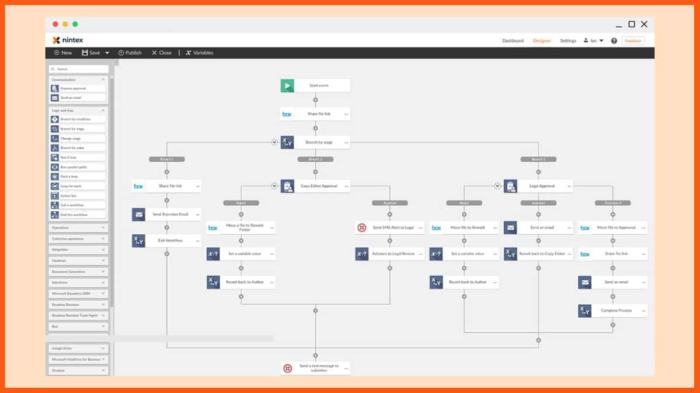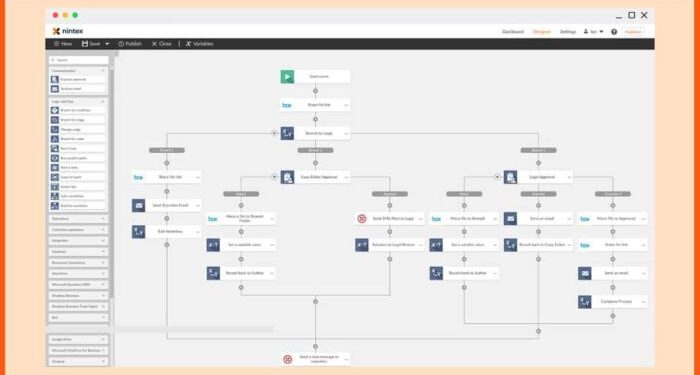Advanced IT automation tools for workflow automation set the stage for this enthralling narrative, offering readers a glimpse into a story that is rich in detail and brimming with originality from the outset. With the rapid evolution of technology, these tools have become essential for organizations looking to streamline their operations and enhance efficiency.
As we delve deeper into the world of advanced IT automation tools, we uncover a realm where innovation meets practicality, revolutionizing the way businesses approach workflow automation.
Overview of Advanced IT Automation Tools
Advanced IT automation tools play a crucial role in streamlining workflows and increasing efficiency in organizations. These tools go beyond basic automation solutions by offering a wide range of features that enhance productivity and effectiveness.
Key Features of Advanced IT Automation Tools
- Orchestration capabilities: Advanced tools can automate complex workflows involving multiple systems and applications, allowing for seamless coordination of tasks.
- Integration with third-party tools: They can integrate with various third-party tools and platforms, enabling a more holistic automation approach.
- Machine learning and AI capabilities: Some advanced tools incorporate machine learning algorithms and artificial intelligence to optimize processes and make intelligent decisions.
- Scalability and flexibility: These tools are designed to scale with the growing needs of an organization and offer flexibility to adapt to changing requirements.
Popular Advanced IT Automation Tools
- Ansible: Ansible is a popular automation tool known for its simplicity and scalability. It allows for the automation of IT infrastructure, application deployment, and configuration management.
- UiPath: UiPath is a leading robotic process automation (RPA) tool that enables the automation of repetitive tasks and workflows across various applications.
- SaltStack: SaltStack is another advanced automation tool that focuses on infrastructure automation and configuration management, providing a high level of control and security.
Benefits of Using Advanced IT Automation Tools

Automation tools have revolutionized the way businesses operate by streamlining processes and increasing efficiency. Incorporating advanced IT automation tools into workflow processes offers a multitude of benefits that can help organizations stay competitive in today's fast-paced digital landscape.
Increased Productivity and Efficiency
- Automation tools eliminate manual tasks, allowing employees to focus on more strategic initiatives that require human intervention.
- By automating repetitive processes, organizations can complete tasks faster and with fewer errors, leading to increased productivity and efficiency.
- Automated workflows ensure consistency in operations, reducing the risk of human error and improving overall quality.
Cost Savings
- By automating routine tasks, organizations can reduce labor costs and reallocate resources to more value-added activities.
- Automation tools help minimize operational costs by improving resource utilization and optimizing workflows.
- Reduced downtime and faster response times can lead to cost savings by preventing delays and maximizing productivity.
Enhanced Accuracy and Compliance
- Automation tools ensure that tasks are executed consistently and accurately, reducing the likelihood of errors and compliance issues.
- By enforcing standardized processes, organizations can achieve regulatory compliance and mitigate risks associated with non-compliance.
- Automated workflows provide audit trails and documentation, facilitating compliance reporting and ensuring transparency.
Real-Life Examples
- Company A implemented an IT automation tool to streamline their customer onboarding process, reducing the time required to onboard new clients by 50%.
- Company B automated their invoice processing system, resulting in a 30% reduction in processing time and a significant decrease in billing errors.
- Company C utilized automation tools to automate server monitoring and maintenance tasks, leading to a 40% decrease in downtime and improved system reliability.
Key Features to Look for in Advanced IT Automation Tools
When choosing an advanced IT automation tool for workflow automation, it is crucial to consider key features that can enhance efficiency and productivity. These features help streamline processes, reduce errors, and improve overall performance.
Integration Capabilities
One essential feature to look for in advanced IT automation tools is robust integration capabilities. The tool should seamlessly integrate with a wide range of systems, applications, and platforms to automate complex workflows across the organization.
Scalability and Flexibility
Another important feature is scalability and flexibility. Advanced IT automation tools should be able to scale with the growing needs of the organization and adapt to changing requirements. They should also offer customization options to tailor automation workflows to specific needs.
Monitoring and Reporting
Advanced IT automation tools should provide comprehensive monitoring and reporting capabilities. This feature allows users to track the performance of automated workflows, identify bottlenecks, and optimize processes for maximum efficiency.
Security and Compliance
Security and compliance are critical considerations when choosing an advanced IT automation tool. The tool should offer robust security features to protect sensitive data and ensure compliance with industry regulations and standards.
Machine Learning and AI Capabilities
Advanced IT automation tools with machine learning and AI capabilities can further enhance automation processes by predicting trends, optimizing workflows, and automating decision-making processes. These features can significantly improve efficiency and accuracy in workflow automation.
Implementation Strategies for Advanced IT Automation Tools
Implementing advanced IT automation tools in an organization requires careful planning and execution to ensure seamless integration and effective utilization. Below are some best practices and tips to consider:
Integration into Existing Workflows
- Assess current workflows and identify areas where automation can streamline processes and improve efficiency.
- Map out the automation process to understand how the new tools will fit in with existing systems and operations.
- Collaborate with different departments to ensure a smooth transition and address any potential challenges or resistance to change.
- Test the automation tools in a controlled environment before full implementation to identify any issues and make necessary adjustments.
Training Staff Effectively
- Provide comprehensive training programs to educate employees on the functionalities and benefits of the new automation tools.
- Offer hands-on training sessions and workshops to allow staff to practice using the tools in a simulated environment.
- Assign dedicated trainers or champions within each team to provide ongoing support and guidance to colleagues during the implementation phase.
- Create user-friendly documentation and resources for quick reference and troubleshooting to empower employees to use the tools effectively on their own.
Final Summary
In conclusion, advanced IT automation tools for workflow automation hold the key to unlocking unprecedented levels of productivity and effectiveness in today's fast-paced digital landscape. By harnessing the power of these tools, organizations can pave the way for a future where efficiency and innovation go hand in hand.
Expert Answers
What are the key features of advanced IT automation tools?
Advanced IT automation tools often include features such as AI integration, advanced analytics, and customizable workflows to optimize automation processes.
How can companies benefit from using advanced IT automation tools?
Companies can benefit from increased efficiency, reduced errors, improved scalability, and enhanced decision-making capabilities by leveraging advanced IT automation tools.










